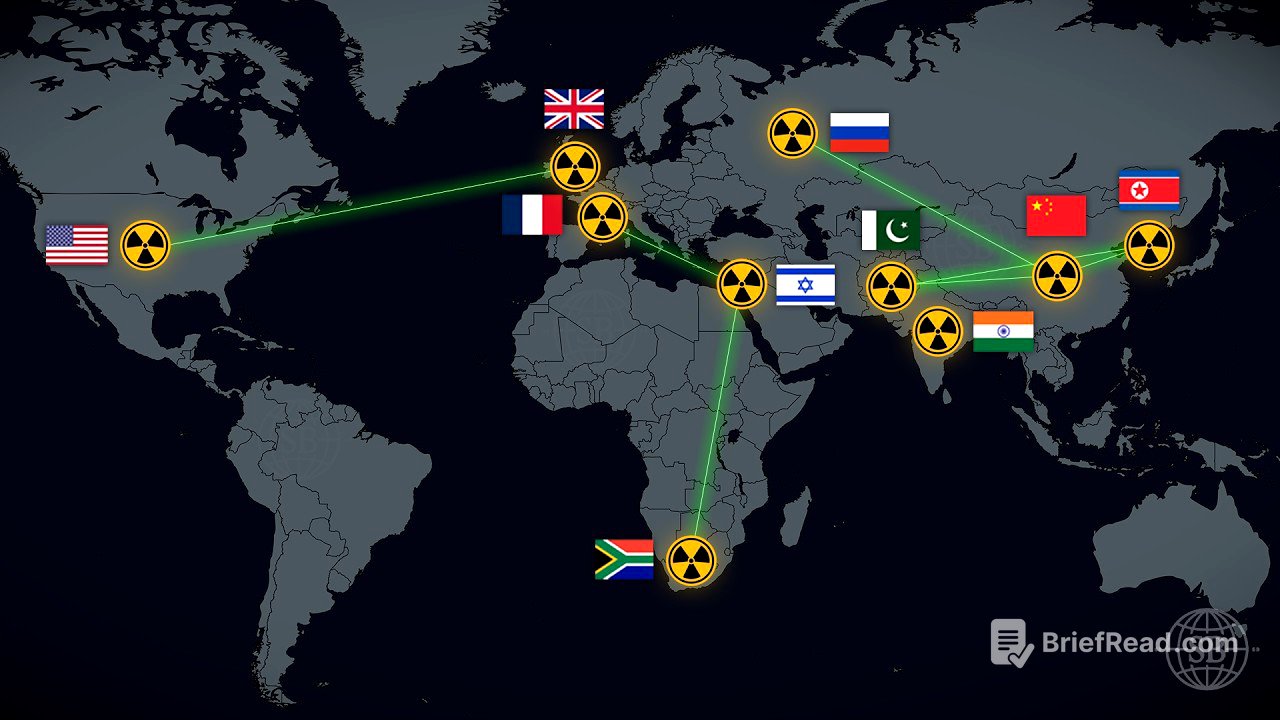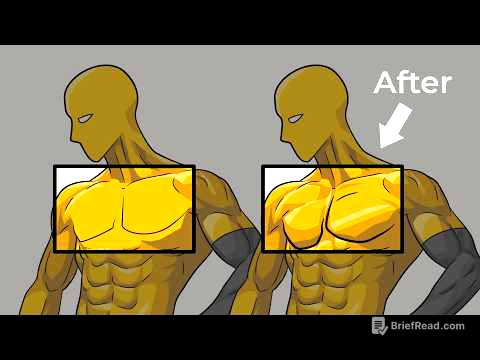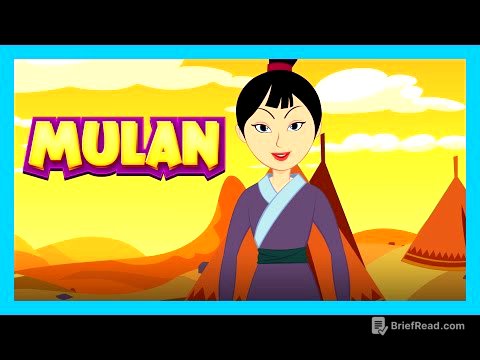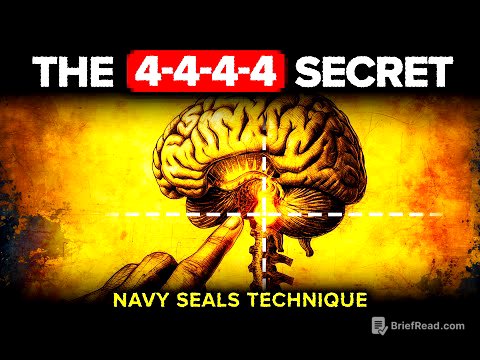TLDR;
The video discusses the history of nuclear weapons development across the globe, starting with the US and then covering the other nine countries that have successfully created them. It also touches upon countries that attempted but didn't succeed, nuclear hosting, nuclear-free zones and the secrecy surrounding these programs.
- US was the first to develop nuke.
- 10 countries around the world have successfully created them.
- Nuclear weapons are stored inside submarines.
Intro [0:00]
The video will explore the timeline of how 10 countries raced to build nuclear technology, the other countries that came close, and might soon be added to the list. It starts in 1938 with the discovery of nuclear fission by German scientists and Albert Einstein warning the US of the dangers of weaponizing this technology.
United States [0:46]
The United States was the first to develop nuclear weapons through the Manhattan Project, a collaborative effort with the UK and Canada during World War II. The US spent a significant portion of its GDP on this project, racing against Germany. The Trinity test in New Mexico was successful, and President Truman informed Stalin about the new weapon. The US then used "Fat Man" and "Little Boy" on Japan, leading to their surrender and the start of a global race to develop nuclear weapons.
Soviet Union [1:52]
The Soviet Union was the second country to develop nuclear weapons, starting in 1941 after noticing the halt in nuclear fission publications by Western scientists. Spying on the US programs provided information, but the Soviets were wary of misinformation. They used captured German scientists and their own research, along with the US designs for verification. In 1949, they successfully completed the RDS-1 test in Kazakhstan, ending the US monopoly and initiating the Cold War arms race.
United Kingdom [2:47]
The United Kingdom pioneered nuclear weapons research with the "Tube Alloys" project, aided by scientists fleeing Germany. Due to resource constraints during World War II, they merged their work with the US Manhattan Project, contributing significant research under the Quebec Agreement. However, in 1945, the US terminated the agreement and didn't share the final results with Britain, prompting the UK to resume its own program. The UK successfully tested "Operation Hurricane" in 1952 in the Montebello Islands, Australia.
Thermonuclear [3:57]
After the Soviet Union developed nukes faster than expected, the US began developing thermonuclear weapons, which use fusion to combine atoms and are more powerful than atom bombs. Despite warnings from scientists like Oppenheimer, President Truman approved the development. In 1952, the US successfully tested "Ivy Mike," a hydrogen bomb 450 times more powerful than the one dropped on Nagasaki. The Soviets and the UK followed with their own thermonuclear tests, leading the US to resign a nuclear agreement with the UK in 1958.
France [4:58]
France was the fourth country to develop nuclear weapons, initially focusing on nuclear energy with collaboration from Israel. The Suez Crisis and tensions between the US and Soviets motivated France to seek its own deterrent strategy. President Charles de Gaulle emphasized the importance of nuclear weapons for France's sovereignty and strategic independence from NATO. France sourced uranium from its colonies and successfully tested "Gerboise Bleue" in Algeria in 1960, followed by its first hydrogen bomb in 1968.
China [6:04]
China became the fifth country with nuclear weapons, aiming to deter the US. Initially, the Soviet Union provided assistance, but a rift developed due to ideological differences. China continued its development independently, overcoming challenges like the Great Leap Forward and Cultural Revolution. They discovered large uranium deposits, which helped. In 1964, China detonated its first atomic bomb, "Project 596," and within 32 months, they tested their first hydrogen bomb, marking the fastest transition from fission to fusion bombs.
Israel [7:04]
Israel is the only nation that has never acknowledged possessing nuclear weapons. They collaborated with France on nuclear energy since the 1950s, with France helping build a secret nuclear facility in the Negev Desert. US President Kennedy was concerned about Israel developing nuclear weapons and demanded inspections, which Israel delayed and staged. Prime Minister David Ben-Gurion was reportedly obsessed with obtaining nuclear weapons, causing tension with the US. Mordechai Vanunu, an Israeli technician, leaked photos and documents detailing the facility's true purpose in 1986. He was then kidnapped by the Mossad and sentenced to 18 years in prison. It is believed that Israel has also developed thermonuclear weapons.
India [9:02]
India, like many others, expressed the need to have nuclear technology for deterrence and protection from Pakistan and China. Research began in the 1940s and accelerated after losing a border war with China in 1962. India developed nuclear energy, getting supplies from countries like Canada and the US, while secretly using them to develop weapons. The first test was successfully completed in 1974, code-named "Smiling Buddha," which they called a peaceful nuclear explosion. This drew worldwide condemnation and sanctions. India refrained from fully weaponizing the technology into warheads until the 1990s.
South Africa [10:14]
South Africa possessed one of the world's largest reserves of natural uranium and supplied it to various countries. They shifted interest into weapons in the 1960s and 70s due to increased Soviet influence and political isolation. In 1977, they created a testing facility but stopped the test due to international pressure. In 1979, a double flash of light was detected, believed to be a joint nuclear test with Israel. By the mid-1980s, South Africa had created six nuclear bombs, likely with Israel's help. In the 1990s, South Africa dismantled and disposed of its nukes, becoming the first nation to do so, and admitted to possessing them.
Pakistan [12:28]
Pakistan began its nuclear program in the 1970s after losing a war with India in 1971. Abdul Qadeer Khan stole intelligence on uranium enrichment from a Dutch nuclear facility, which was crucial to their program. China provided expertise, materials, and blueprints. The US did little to stop Pakistan's program due to their alliance against the Soviet invasion of Afghanistan. In 1998, after India detonated five warheads, Pakistan also detonated five bombs, successfully completing their first test. Pakistan operates a first-use policy, which has deterred India in conflicts. Abdul Qadeer Khan confessed to illegally selling nuclear weapons technology to North Korea, Iran, and Libya.
North Korea [14:59]
North Korea became the tenth country to develop nuclear weapons. Kim Il-sung saw nuclear weapons as crucial for his regime's survival. The Soviet Union initially helped them develop nuclear research facilities. North Korea focused on building its own program using its uranium deposits. By the 1980s, the US became aware that North Korea was using spent nuclear energy fuel on creating weapons. North Korea withdrew from the non-proliferation treaty and continued its weapons program. In 2005, Kim Jong-il claimed to possess functional nuclear weapons, and in 2006, they completed their first successful nuclear test.
Nuclear Hosting [17:12]
Many countries hosted nukes from other countries under alliances for protection and deterrence during the Cold War. The United States held nuclear weapons in various countries, including Belgium, Germany, Italy, and Turkey. The Soviet Union also stored significant amounts in their Soviet republics. While most of these were removed, US nukes still remain in some countries, and Russia has provided Belarus with warheads in 2023.
Countries That Tried [18:15]
Several countries were working on developing their own nuclear weapons but abandoned the work due to international pressure or lack of resources. These include Argentina, Brazil, Sweden, Romania, Algeria, Libya, Iraq, Iran, Egypt, Syria, Taiwan, and Japan. Some, like Iraq, Syria, and Iran, made significant progress but had facilities destroyed or sabotaged. Iran is speculated to be the next closest to developing nukes, which Israel is keen to prevent.
Nuclear Free Zones [19:26]
Argentina and Brazil were extremely close to completing their nuclear development. Mexico proposed the Treaty of Tlatelolco, declaring Latin America a nuclear-free zone, which every country in the region eventually signed. Similar treaties are in place around the world, agreeing not to host, develop, or test nuclear weapons, such as the Treaty of Rarotonga, Pelindaba Treaty, Semipalatinsk Treaty, Bangkok Treaty, and the Antarctic Treaty.
Secrecy [20:18]
While these treaties are useful, most of the world's nuclear-armed states store their nuclear weapons inside submarines, making them secretly hidden everywhere in the oceans. This acts as a strong deterrence. Creating nuclear weapons is an extremely expensive and conspicuous process, making it hard to have a secret nuclear program without the world knowing. It's likely only a matter of time until more nations are added to the list of nuclear powers.









